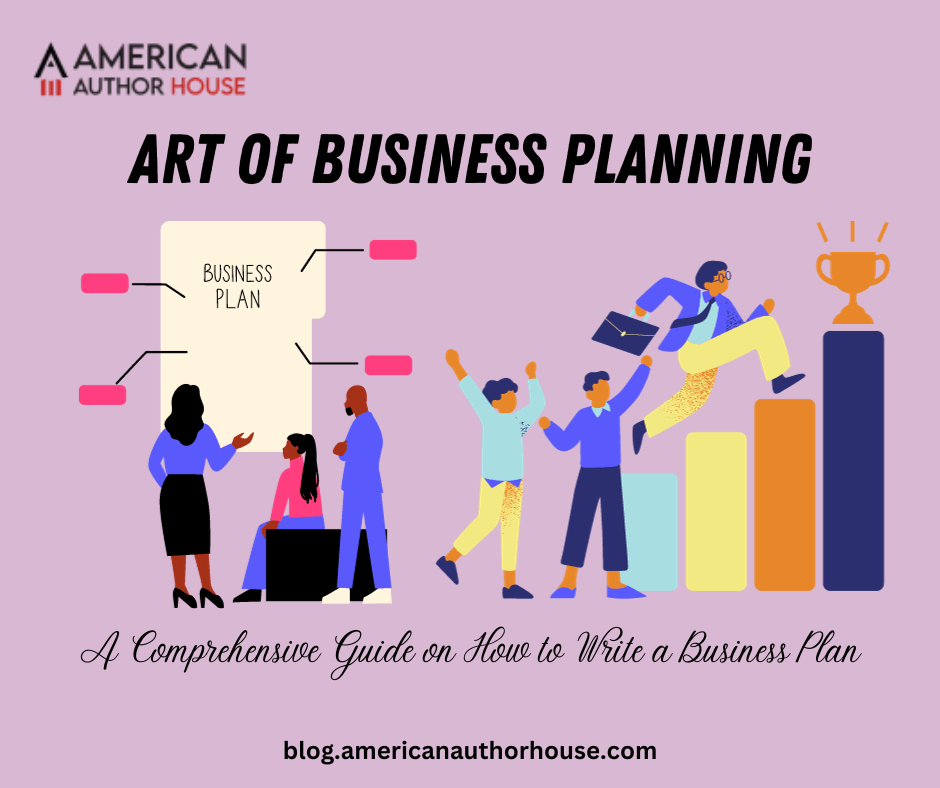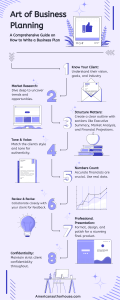
Marketing
Business Planning is one of the most important decisions you can make for your venture. This step-by-step guide will help you organize your thoughts, ideas and aspirations in order to bring them into reality.
By following this process crafted especially by American Author House experts, you will be able to develop all the components needed for any Business Planning mode.
How to Write a Successful Business Plan?
As you begin to write your business plan, you must understand the purpose of Business Planning. A successful plan will help identify your product or service’s target audience and define their needs. It also helps in understanding the industry and competitors as well as determining what strengths and weaknesses your company has.
If you are new and are not aware of how to write a good business plan well, then follow the guide below and craft an amazing business plan in no time.

Company Overview
The Company Overview section is a good place to start because it establishes the foundation for your Business Planning. It’s also one of the most important sections, as it gives you an opportunity to share information about your company with potential investors and lenders.
The key points covered in this section include:
Company History
How did your company come about? What has led up to its current form?
Products and Services
What do you sell? Who are your customers? Why should people buy what you’re selling (or use whatever service or product)? What makes these products unique compared with competitors’ offerings?
Mission & Vision Statements
What is your ultimate goal with this venture? Where do you see yourself going in five years –or ten years –and how will success be measured along each step along that path (e.g., sales projections)?
Marketing and Sales Plan
The next step is to figure out your sales and marketing plan for your Business Planning model. The marketing plan is a blueprint for how you will market your business. It includes how much money you’re going to spend on marketing, what mediums are best for reaching your target audience and when. You should also include any long-term goals or strategies that might require additional funding from investors or other sources.
The sales strategy is the part of your business plan where you detail how much product or service will be sold in what period by whom. This could include anything from an employee-based sales team to an independent contractor network or even both!
Financial Management Plan
Financial management is the process of managing business money and is very important to look at when Business Planning.
A financial plan is a detailed plan that describes the financial requirements of a business and should be part of your overall business plan. To understand the importance of financial planning, read our article on Cost of Publishing a Book – Understanding the Financial Aspects of Publishing. It should be based on your company’s goals and objectives, as well as its strengths, weaknesses, opportunities, and threats (SWOT).
The financial section is one of the most important parts of your business plan. It is because it helps you determine how much money you will need to start up or grow your company. If there isn’t enough cash flow coming in from sales or other sources, then there won’t be enough funds available for day-to-day operations. So, in that case, starting or running a business long-term will not be a feasible idea, which you will be able to see in this section.
Human Resource Management Plan
Human resource management is a critical component of any Business Planning. The people you hire are your most valuable asset and can make or break your company. So, it’s important to hire the right people for each position and then manage them effectively. And how can you achieve that, you wonder? Well, you need to keep the following things in mind.
- Hire based on skills, not just experience or education level
- Develop an interview process that identifies candidates’ strengths, weaknesses, motivations and goals.
- Consider using personality tests such as Myers-Briggs Type Indicator (MBTI) or DISC Assessment (developed by William Moulton Marston) to help identify personality types that match those required by job descriptions.
Risk Management Plan
Another very crucial component of Business Planning is the risk management plan as well. You also need to make sure of how much risk you are undertaking.
Risks are the potential for loss or damage to your business. They can be financial, operational or strategic, and they’re not always easy to identify. The good news is that there are ways you can minimize risk by identifying it before it becomes an issue.
The first step is knowing what kind of risks your business might face–and that means understanding what types of risks exist. Here are some common types:
Financial
These include market conditions like high interest rates or low consumer confidence. You also need to focus on economic factors such as inflation rates, political climates like war or natural disasters (like earthquakes), and technological advances.
Operational
These include supply chain disruptions caused by weather events such as storms at factories where parts are made. It may also include human error when making mistakes during assembly lines at manufacturing plants or accidents involving forklift trucks.
Strategic
Strategic risks include losing key employees who may leave unexpectedly due to their reasons rather than yours. Or changing regulations regarding environmental impact statements related to environmental issues within communities near chemical plants owned by big corporations.
These are a few of the many risk analyses that you need to be making when you are making a business plan in order to have a good and clear big picture.
Essential Elements and Detailed Insights
| Section | Key Components | Details |
|---|---|---|
| Company Overview | History, Products/Services, Mission & Vision | Brief history of the company, an overview of products or services offered, and the company’s mission and vision statements. |
| Marketing and Sales Plan | Marketing Strategy, Sales Strategy | Outline of marketing approaches and platforms, along with a detailed sales strategy including sales targets and methodologies. |
| Financial Management Plan | Financial Requirements, Cash Flow | Details on initial financial needs, ongoing operational costs, and cash flow management strategies. |
| Human Resource Management Plan | Recruitment, Management Strategies | Guidelines on hiring practices, including what to look for in candidates, and strategies for effectively managing personnel. |
| Risk Management Plan | Types of Risks (Financial, Operational, Strategic) | Identification and management strategies for various risks including financial uncertainties, operational hiccups, and strategic challenges. |
| Call to Action | Next Steps for the Reader | Encouraging readers to begin their own business planning process using the guide and steps provided, and suggesting further resources for assistance. |
Conclusion
Business planning is an important tool for any entrepreneur to have in their arsenal. It helps you to make better decisions, plan and avoid mistakes that could cost you time or money.
With so much information out there on how to write a business plan, it can be overwhelming at first glance. But don’t worry – we’ve got your back!
Our goal with this guide was not only to provide an overview of what goes into creating one but also to give you some tips about how to go about doing so effectively. This way, when it comes time for us all (or someone else) to turn those ideas into reality together, they will know what to do.
unexpectedly due to their reasons rather than yours. Or changing regulations regarding environmental impact statements related to environmental issues within communities near chemical plants owned by big corporations.
These are a few of the many risk analyses that you need to be making when you are making a business plan in order to have a good and clear big picture.



